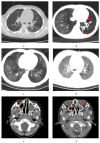Clinical Characteristics and Immune Responses in Children with Primary Ciliary Dyskinesia during Pneumonia Episodes: A Case-Control Study
- PMID: 38002818
- PMCID: PMC10670724
- DOI: 10.3390/children10111727
Clinical Characteristics and Immune Responses in Children with Primary Ciliary Dyskinesia during Pneumonia Episodes: A Case-Control Study
Abstract
Objective: This study explored the clinical features and immune responses of children with primary ciliary dyskinesia (PCD) during pneumonia episodes.
Methods: The 61 children with PCD who were admitted to hospital because of pneumonia were retrospectively enrolled into this study between April 2017 and August 2022. A total of 61 children with pneumonia but without chronic diseases were enrolled as the control group. The clinical characteristics, levels of inflammatory indicators, pathogens, and imaging features of the lungs were compared between the two groups.
Results: The PCD group had higher levels of lymphocytes (42.80% versus 36.00%, p = 0.029) and eosinophils (2.40% versus 1.25%, p = 0.020), but lower neutrophil counts (3.99 versus 5.75 × 109/L, p = 0.011), percentages of neutrophils (46.39% versus 54.24%, p = 0.014), CRP (0.40 versus 4.20 mg/L, p < 0.001) and fibrinogen (257.50 versus 338.00 mg/dL, p = 0.010) levels. Children with PCD and children without chronic diseases were both most commonly infected with Mycoplasma pneumoniae (24.6% versus 51.9%). Children with PCD had significantly more common imaging features, including mucous plugging (p = 0.042), emphysema (p = 0.007), bronchiectasis (p < 0.001), mosaic attenuation (p = 0.012), interstitial inflammation (p = 0.015), and sinusitis (p < 0.001).
Conclusion: PCD is linked to immune system impairment, which significantly contributes to our understanding of the pathophysiology of this entity.
Keywords: imaging examination; immunology; inflammation; pathogen; pneumonia; primary ciliary dyskinesia.
Conflict of interest statement
The authors declare no conflict of interest.
Figures





Similar articles
-
[Clinical characteristics of primary ciliary dyskinesia in children].Zhonghua Er Ke Za Zhi. 2008 Aug;46(8):618-22. Zhonghua Er Ke Za Zhi. 2008. PMID: 19099837 Chinese.
-
Computed tomography in adult patients with primary ciliary dyskinesia: Typical imaging findings.PLoS One. 2018 Feb 6;13(2):e0191457. doi: 10.1371/journal.pone.0191457. eCollection 2018. PLoS One. 2018. PMID: 29408869 Free PMC article.
-
Prevalence of chronic rhinosinusitis in bronchiectasis patients suspected of ciliary dyskinesia.Int Forum Allergy Rhinol. 2019 Dec;9(12):1430-1435. doi: 10.1002/alr.22414. Epub 2019 Aug 20. Int Forum Allergy Rhinol. 2019. PMID: 31430425 Free PMC article.
-
Bacteriology and treatment of infections in the upper and lower airways in patients with primary ciliary dyskinesia: adressing the paranasal sinuses.Dan Med J. 2017 May;64(5):B5361. Dan Med J. 2017. PMID: 28552099 Review.
-
[Primary ciliary dyskinesia: a retrospective review of clinical and paraclinical data].Rev Mal Respir. 2011 Sep;28(7):856-63. doi: 10.1016/j.rmr.2011.02.014. Epub 2011 Sep 3. Rev Mal Respir. 2011. PMID: 21943530 Review. French.
References
-
- Chapelin C.A., Coste P., Reinert M., Boucherat M.C., Millepied F.P., Escudier E. Incidence of Primary Ciliary Dyskinesia in Children with Recurrent Respiratory Diseases. Pt 1Ann. Otol. Rhinol. Laryngol. 1997;106:854–858. - PubMed
Grants and funding
LinkOut - more resources
Full Text Sources
Research Materials
Miscellaneous

